|
On Monday, the 4th,
I got up and decided that I'd use my morning to revisit Reifel
and try to get photos of the birds I'd missed the day before.
I put my equipment in the car and headed south. The route I had
chosen goes near Boundary Bay, so I decided to stop by while I
was in the vicinity. As I reached the area, though, it was covered
in a blanket o' fog.
|
|
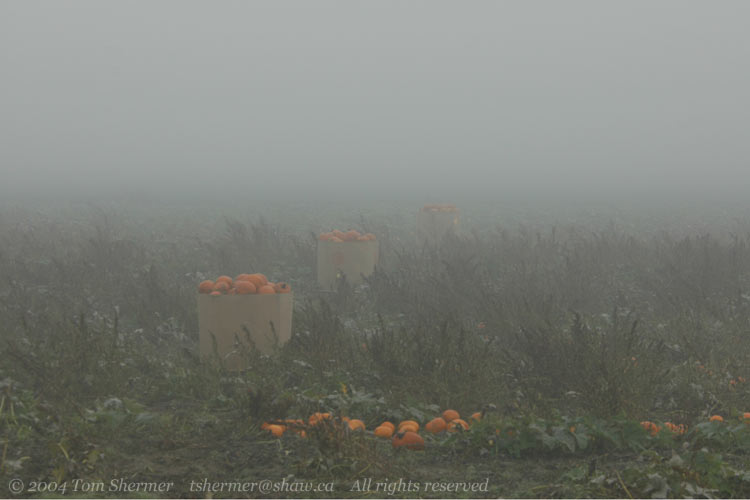 |
| I parked
at the foot of 104th Street and as I was walking up to the dyke,
there were several White-crowned Sparrows in the vegetation on the
right. Both of the following two photos are White-crowneds; the
first is a juvenile, and the second is an adult. |
|
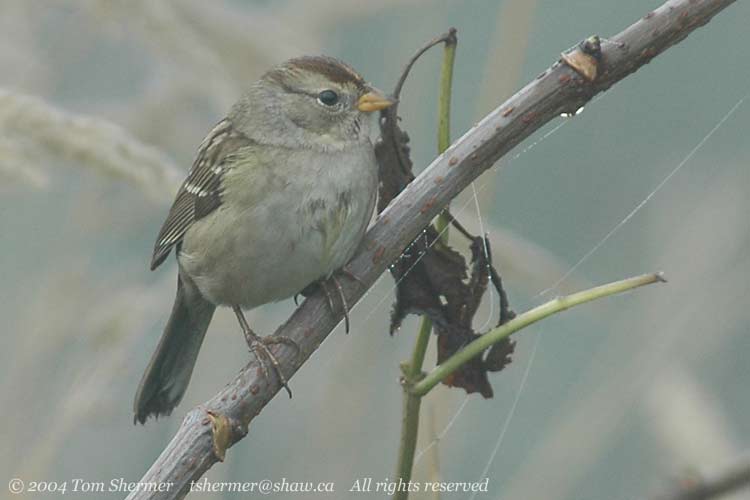 |
| |
|
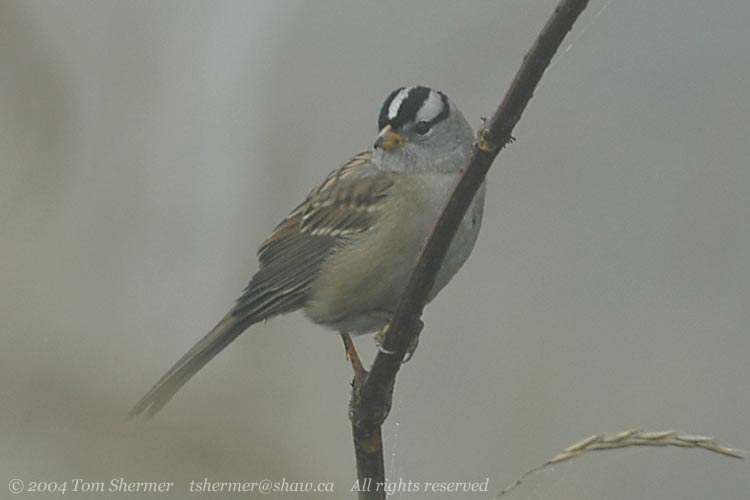 |
| The fog
was pretty thick and I couldn't see very far onto the tidal flat
or along the dyke. |
|
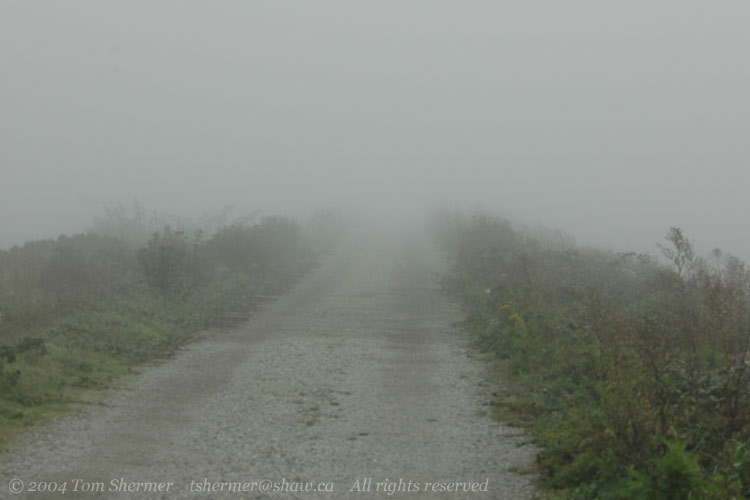 |
|
As I walked along,
I could hear Kildeer calling from the flats. Somehow their calls
made the morning seem all the more desolate.
On the land side of
the dyke, I noticed a Savannah Sparrow perched behind a spiderweb.
|
|
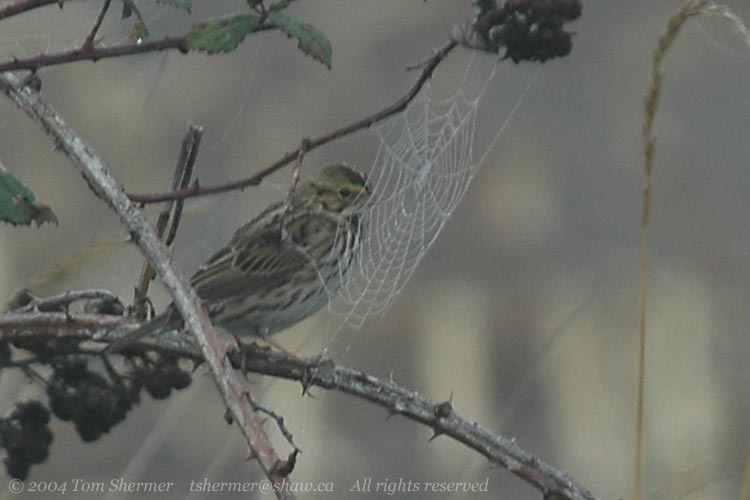 |
|
I think it was there
by accident--I didn't see it hunting spiders or taking the spider's
prey.
Now the spiderwebs
had caught my eye. The foggy morning had deposited drops of dew
all along the webs, and it made the webs really stand out. It
probably didn't bode well for the spiders' chances of eating that
morning. There were plenty of webs near the dyke...here's another
one.
|
|
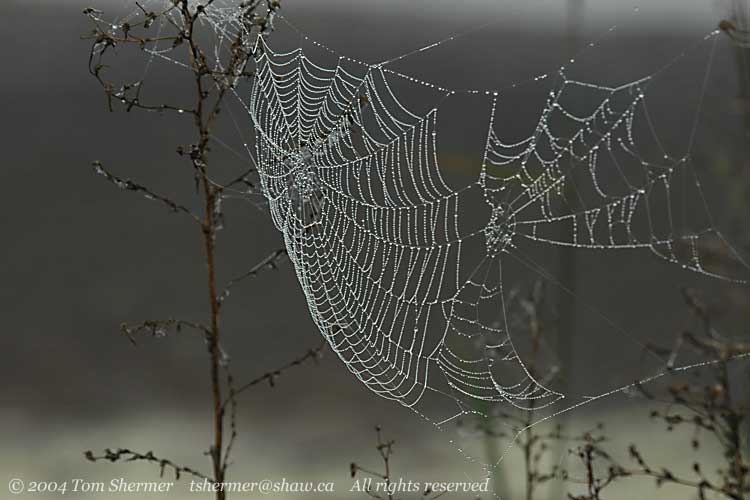 |
|
It was a lovely walk
out on the dyke, with the damp and the chill and the Kildeer and
the occasional illusion of a shifting form in the fog. But the
bird action was pretty low-key, so I decided to head back to my
car and over to Reifel.
As I was leaving the
dyke, I found an unusual sparrow at the side of the gate. Well,
the sparrow wasn't really unusual, it's just one that I haven't
seen before. I wasn't able to identify it then, but now I can
tell that it's a Lincoln's Sparrow. And a handsome little guy,
at that.
|
|
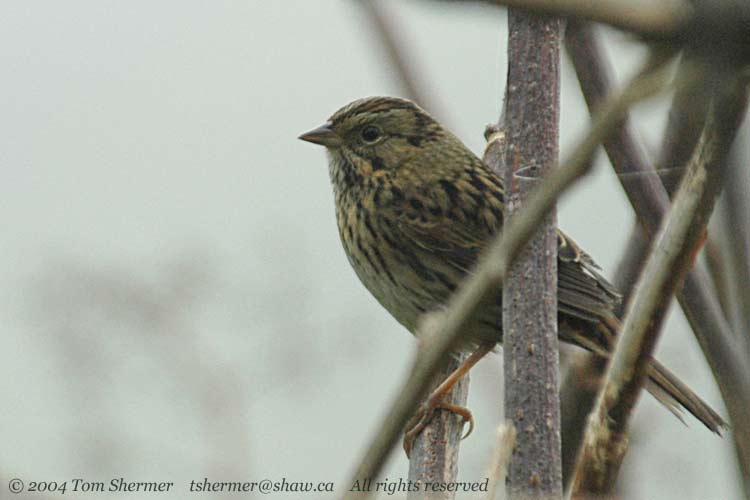 |
| I drove
over to Reifel without incident, and headed in. As is often the
case, the first birds I saw were House Sparrows. Here's a juvenile
or a female--they have similar plumages and I can't tell them apart. |
|
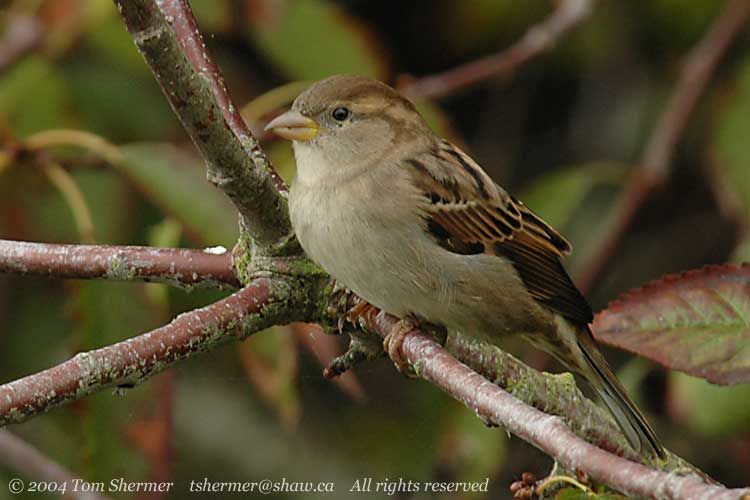 |
|
And here's a male.
Either he's in molt or he's very tattered and worn, or both.
|
|
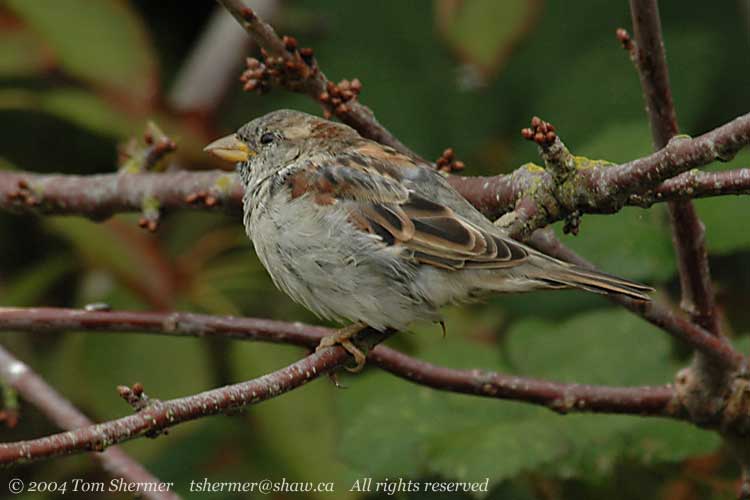 |
|
The House Sparrows
were hanging out in the bushes a little ways past the entrance.
I headed off towards
the middle dyke, but I only got about forty paces before I noticed
this little girl, who was being all cute.
|
|
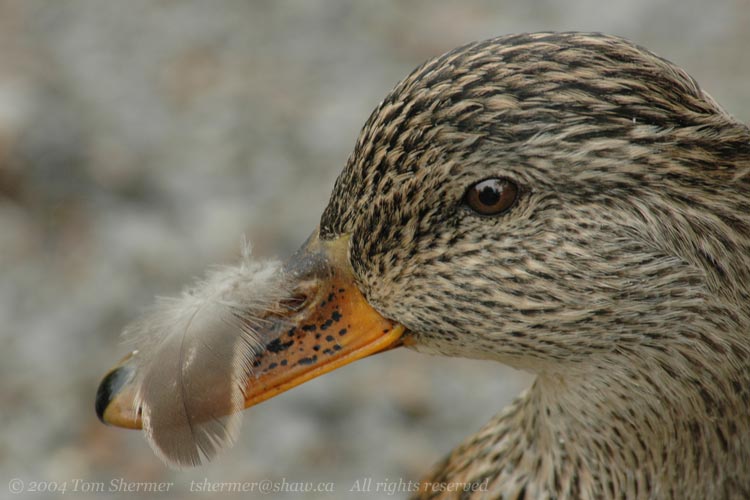 |
|
When I finished taking
photos of her, I saw some very interesting feet lurking about.
I did a double-take when I first saw them. They say that birds
are the closest living relatives to dinosaurs...these feet and
legs make me believe it.
|
|
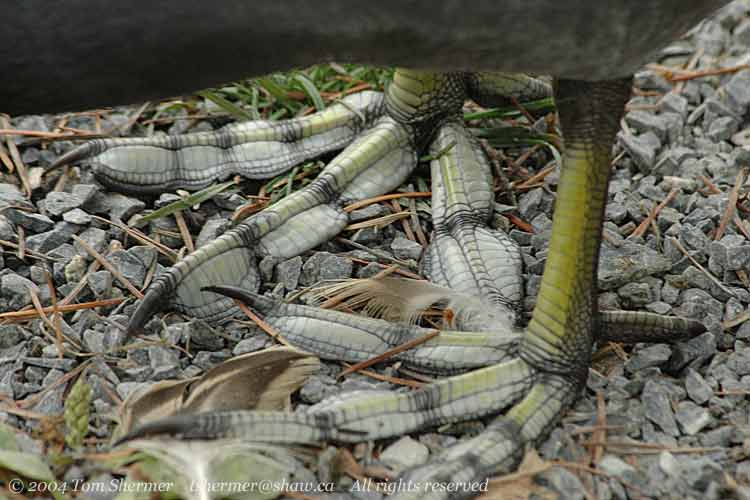 |
|
So, we have foot quiz
question #1: can you name the bird with the feet shown above?
(Answers are at the end.)
Well, I proceeded up
to where we had seen the Yellow-rumped Warblers the day before,
and there were still a whole bunch of them there. There are two
main subspecies of the Yellow-rumped: the Audubon's and the Myrtle.
There were both of them in this little flock. The most distinctive
field mark for distinguishing between the two is the yellow or
yellowish throat of the Audubon's vs. the white or whitish throat
of the Myrtle. That would mean that this is an Audubon's.
|
|
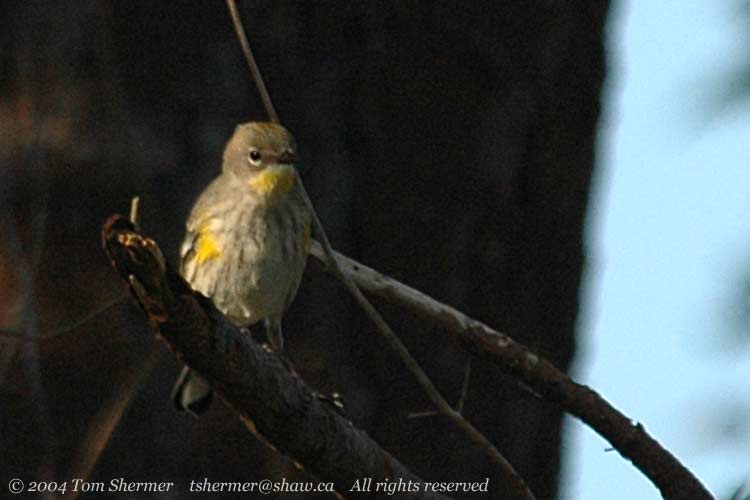 |
| And that
the following is a Myrtle. |
|
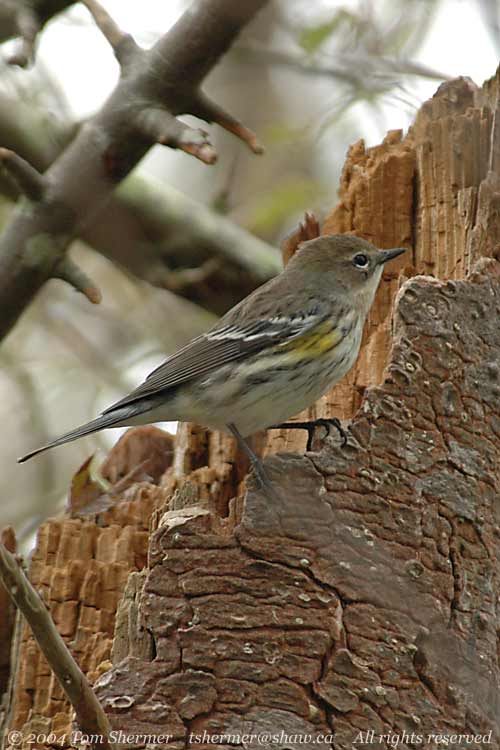 |
|
The fact that those
two birds were brown means that they are in their first year.
Adults are mostly grey. Most of the warblers in the flock were
first-year, but there were a few adults around. Maybe they were
chaperones.
Although the photos
haven't shown it well, it was foggy at Reifel. Every now and then
a small flight of Snow Geese would fly over me in the fog or low
clouds. I would hear the muffled goose honks get louder for a
while, and then, looking up, a few geese would appear out of the
clouds, fly over me, and then disappear again into the clouds
as their honks faded away. I stopped and took a few photos of
these almost ghostly flights.
|
|
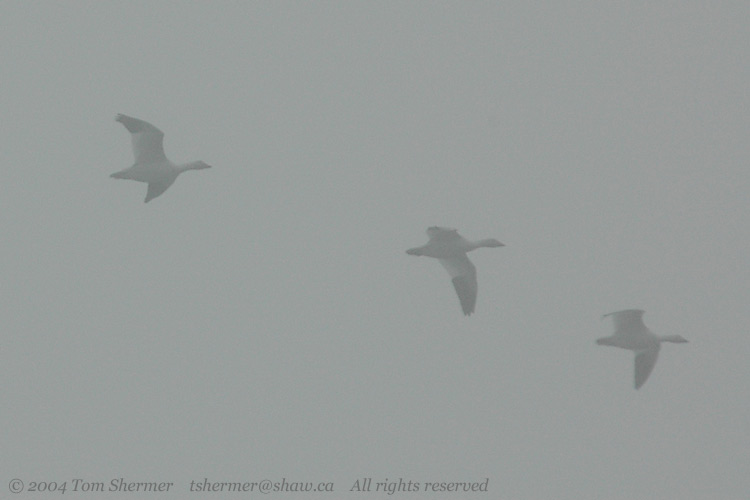 |
|
I proceeded down the
middle dyke towards the tower. About ten meters from the main
intersection by the tower, I spied some movement on a tree trunk
and found a Brown Creeper. I managed to get quite close and got
some good close-ups of him. Here he is with a bug in his mouth.
|
|
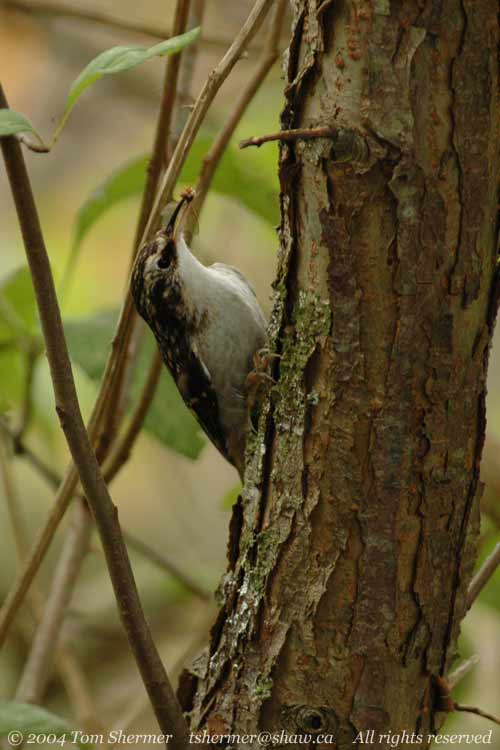 |
|
And here's a later
photo, showing his curved bill, back plumage, and cool feet, which
are specialized for the creeper's favorite activity of hopping
up the side of trees.
|
|
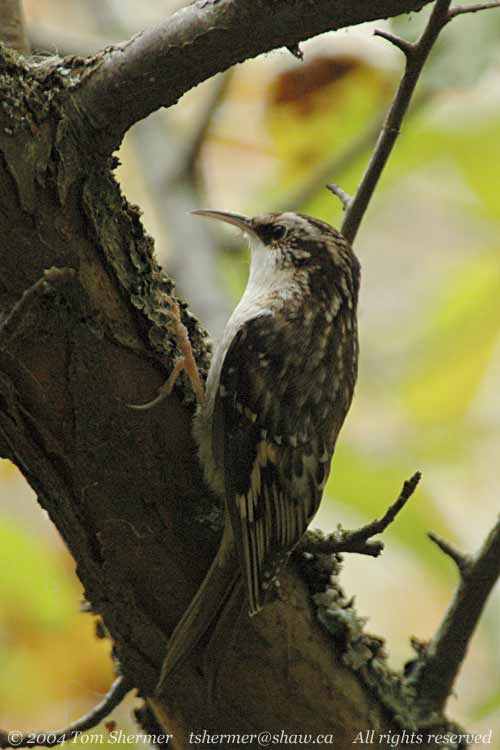 |
|
I thought about making
the creeper part of the foot quiz, but that would maybe have been
too tough. Not that the foot quiz is easy.
Speaking of which,
I was pretty happy about all the good Brown Creeper shots I had
gotten as I climbed up onto the observation tower. There I ran
into the second set of feet in the quiz. (Don't worry, this is
the last question, and you won't be marked on the quiz.)
|
|
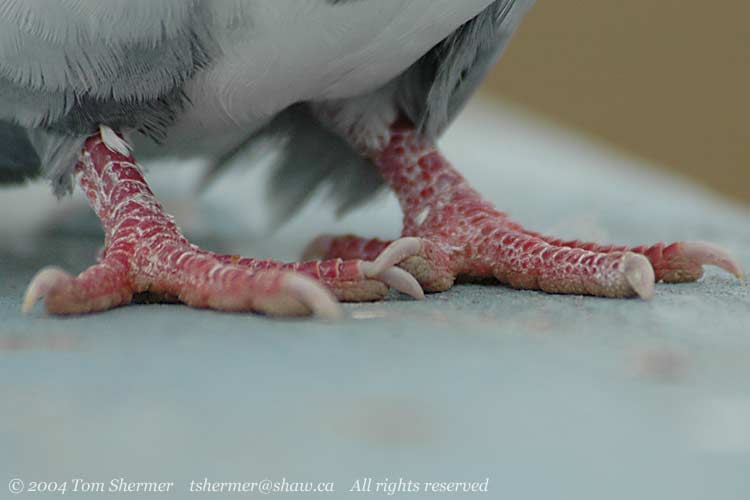 |
|
So, foot quiz question
#2: can you name the bird with the red feet shown above? (Answer
at the end.)
Aside from the guy
with the red feet, nothing much was happening at the tower. There
were two of each Yellowlegs and about thirty of Long-billed Dowitchers
at the base. I
did see a Peregrine Falcon go by, but wasn't quick enough with
my camera.
The fog lifted a bit,
and I searched along the northwest corner for Mountain Chickadees.
This is where we had seen one the day before. While I was out
there, I could hear lots of honking from a huge flock of Snow
Geese out on the foreshore. At one point, the ruckus really intensified,
and the flock took off. Here they are rising up over the marsh--imagine
the following density of geese for as far as you can see. There
were tens if not hundreds of thousands of birds.
|
|
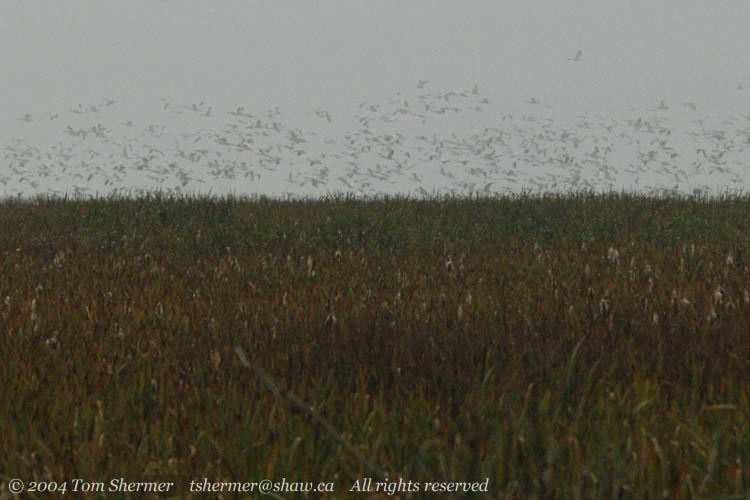 |
|
Well, the northwest
corner was a bust for chickadees, so I started looking
east of the tower. In the fields to the north, I found a bird
nearing the other extreme of size, a Great Blue Heron.
|
|
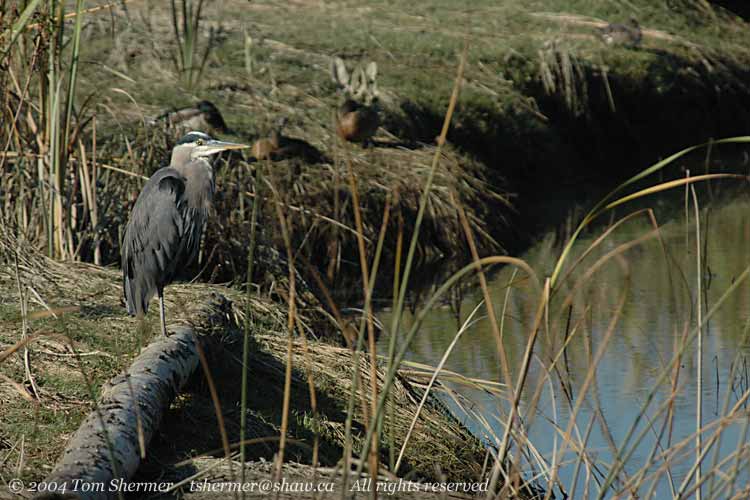 |
| I eventually
found some chickadees, but they were Black-capped Chickadees. Here's
one of them at a feeder. |
|
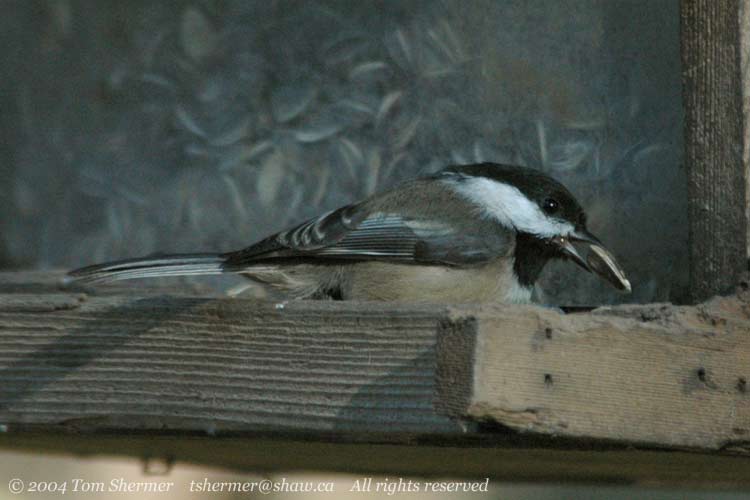 |
|
He's a cutie, but he's
not a Mountain.
So I continued looking
for Mountain Chickadees. Eventually I found another type of chickadee,
but it was a Chestnut-backed Chickadee. He looks like a Black-capped
except for the very red-brown back and flank color. (Compare the
buff flanks and olive-grey back of the Black-capped, above.)
|
|
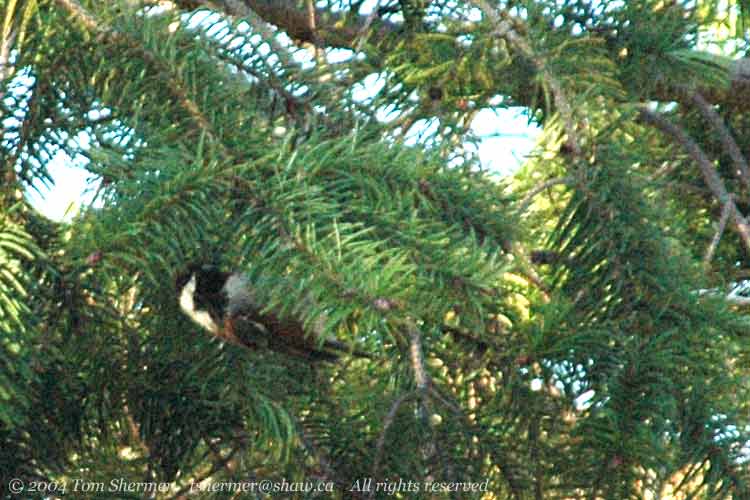 |
|
Perseverance carried
the day and I did eventually find a flock of about six Mountain
Chickadees. They look like Black-cappeds with an extra white stripe
above the eye. I saw them across a channel of water, so I only
got distant shots. Here's a couple of shots of one in flight.
|
|
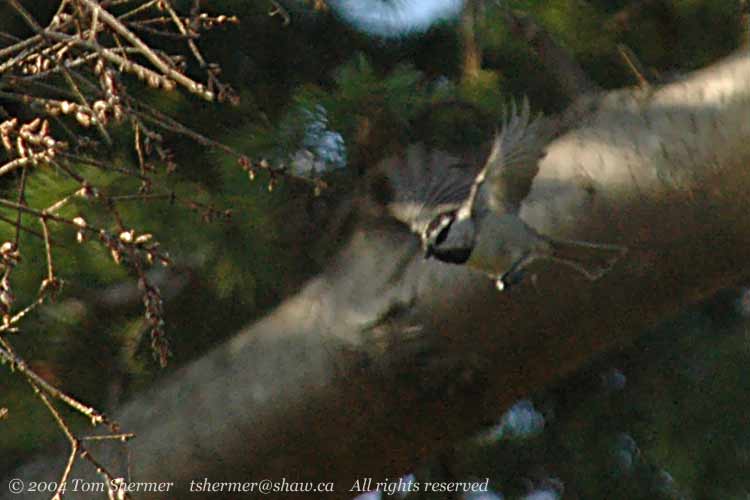 |
| |
|
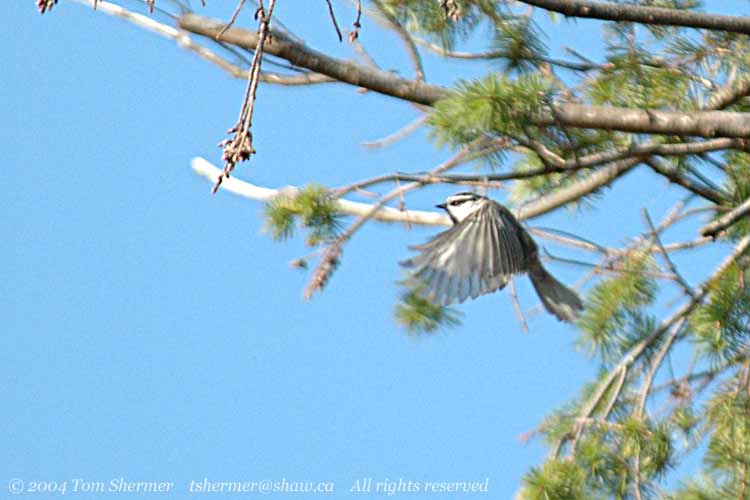 |
| And here's
one perched. |
|
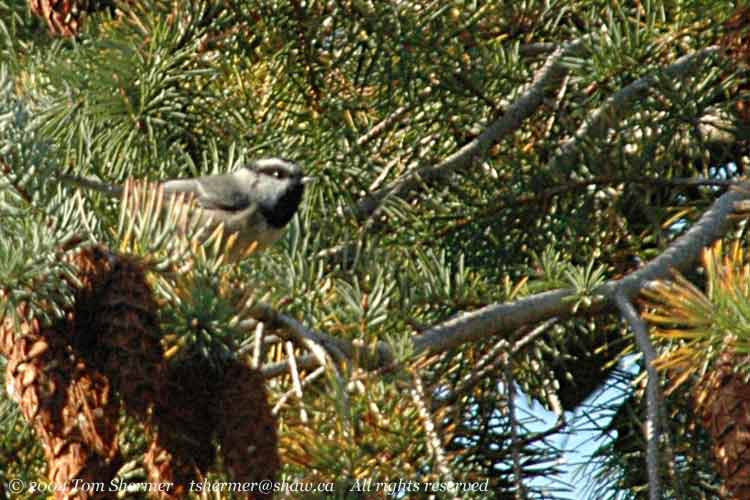 |
|
Despite being tired
(this being my fourth day in a row toting my camera gear around
for hours) I was extremely happy about having found and photographed
the Mountains. Things were going well.
But I did notice that
I was tired and so I started to head for the exit. On my way,
I found a yellow-bodied warbler with a pointy orange/pink bill.
It may be a Wilson's, but I didn't get any conclusive photos.
|
|
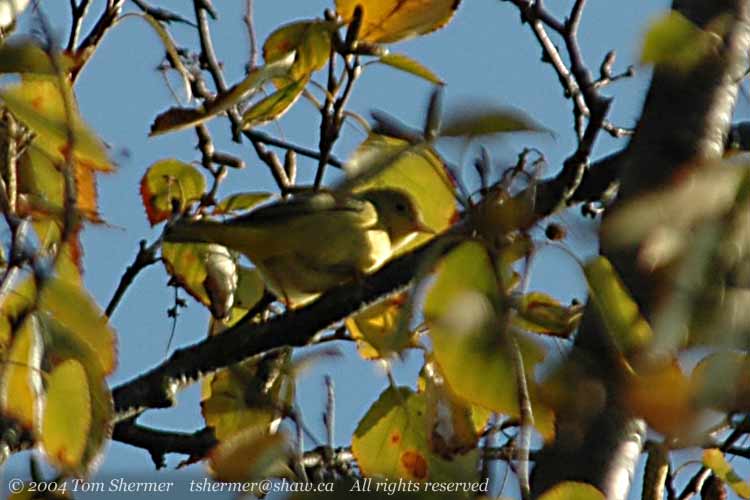 |
| I saw nothing
else except more Yellow-rumped Warblers on my way out. The fog was
quickly moving back in. When I got to the parking lot, I took some
final photos of some mallards that were flying by. Here's one of
them. |
|
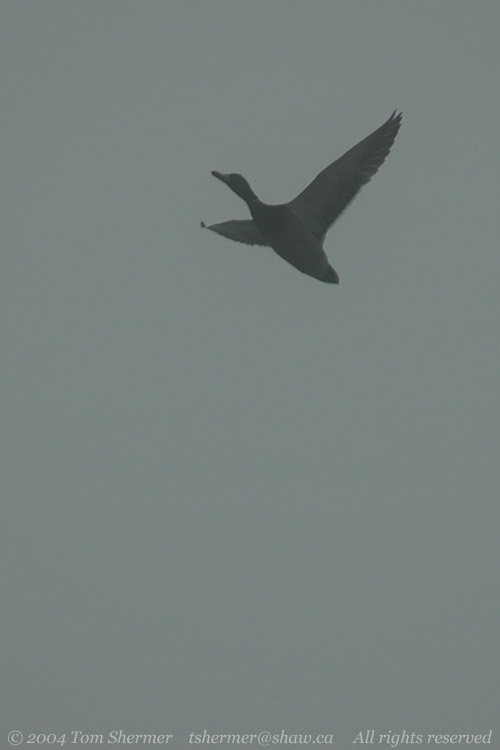 |
| I decided
to take River Road home, which is the middle of the three basic
routes from Reifel to my place (It also has the least amount of
highway, so it's the slowest). But the gods must have been with
me that day, as I drove right past a Red-tailed Hawk on a post beside
the road. I made a U-turn and pulled off across the road from him
to take photos. |
|
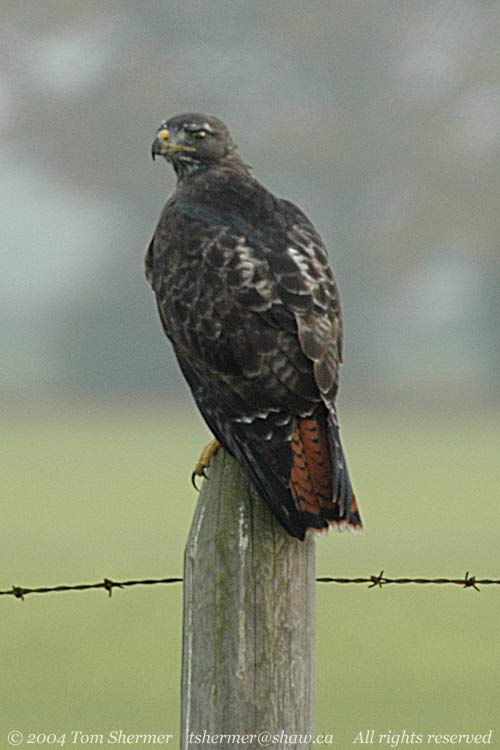 |
|
He only tolerated me
for about ten photos or so before flying off. Hawks are like that.
I was happy with what I'd gotten from him, though.
I had used considerably
more than the morning in my adventure, and so I didn't make it
in to work that day. All in all, though, it was quite a successful
day. I made up for the work later in the week.
Checkin' for Chickadees,
Tom
The answer to foot
quiz question #1 is the American Coot. Strange-lookin' fella,
ain't he?
|
|
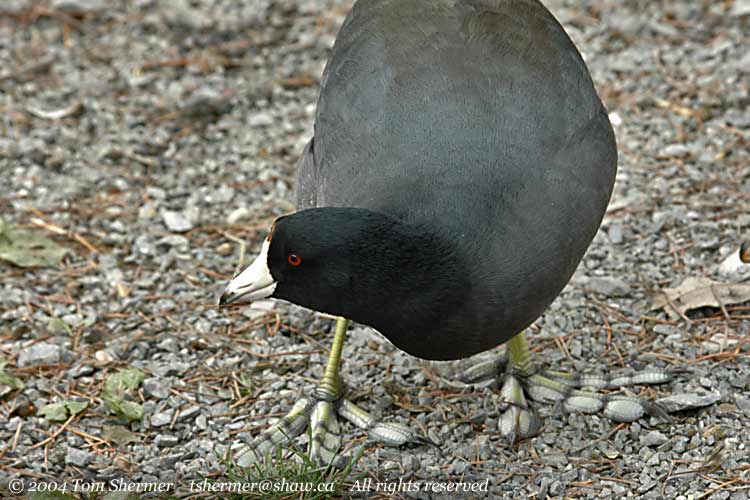 |
| And the
answer to foot quiz question #2 is the Rock Dove, or as you may
know him, the (common) Pigeon. |
|
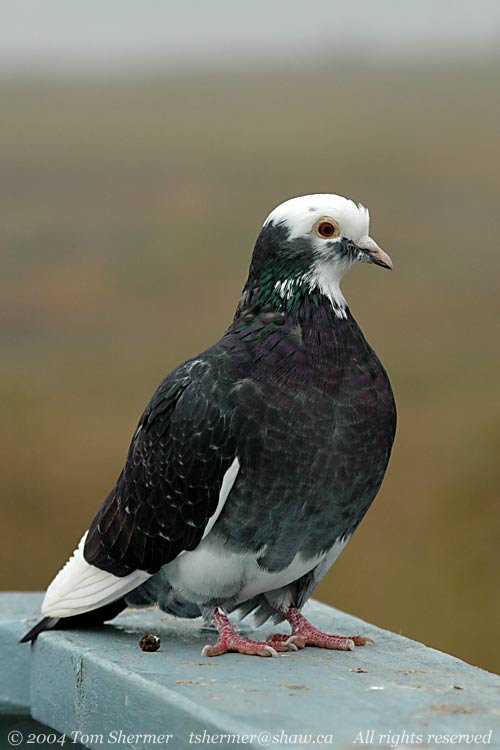 |
|
|
|